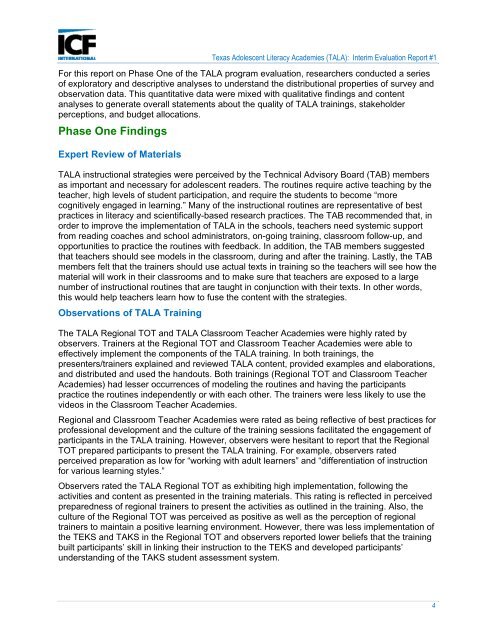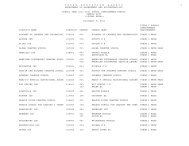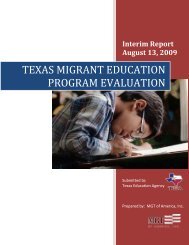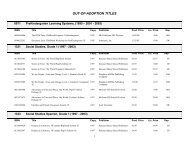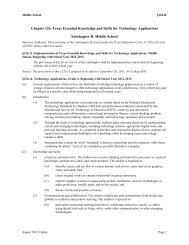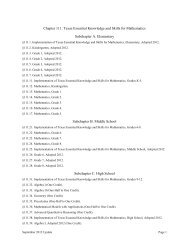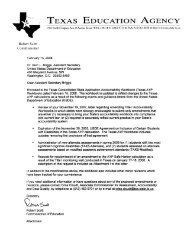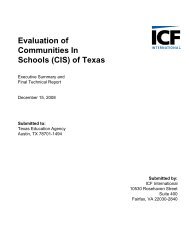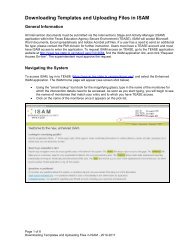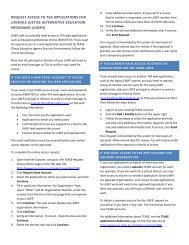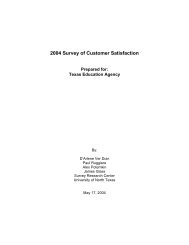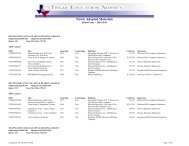Evaluation of the Texas Adolescent Literacy Academies (TALA ...
Evaluation of the Texas Adolescent Literacy Academies (TALA ...
Evaluation of the Texas Adolescent Literacy Academies (TALA ...
- No tags were found...
You also want an ePaper? Increase the reach of your titles
YUMPU automatically turns print PDFs into web optimized ePapers that Google loves.
<strong>Texas</strong> <strong>Adolescent</strong> <strong>Literacy</strong> <strong>Academies</strong> (<strong>TALA</strong>): Interim <strong>Evaluation</strong> Report #1For this report on Phase One <strong>of</strong> <strong>the</strong> <strong>TALA</strong> program evaluation, researchers conducted a series<strong>of</strong> exploratory and descriptive analyses to understand <strong>the</strong> distributional properties <strong>of</strong> survey andobservation data. This quantitative data were mixed with qualitative findings and contentanalyses to generate overall statements about <strong>the</strong> quality <strong>of</strong> <strong>TALA</strong> trainings, stakeholderperceptions, and budget allocations.Phase One FindingsExpert Review <strong>of</strong> Materials<strong>TALA</strong> instructional strategies were perceived by <strong>the</strong> Technical Advisory Board (TAB) membersas important and necessary for adolescent readers. The routines require active teaching by <strong>the</strong>teacher, high levels <strong>of</strong> student participation, and require <strong>the</strong> students to become “morecognitively engaged in learning.” Many <strong>of</strong> <strong>the</strong> instructional routines are representative <strong>of</strong> bestpractices in literacy and scientifically-based research practices. The TAB recommended that, inorder to improve <strong>the</strong> implementation <strong>of</strong> <strong>TALA</strong> in <strong>the</strong> schools, teachers need systemic supportfrom reading coaches and school administrators, on-going training, classroom follow-up, andopportunities to practice <strong>the</strong> routines with feedback. In addition, <strong>the</strong> TAB members suggestedthat teachers should see models in <strong>the</strong> classroom, during and after <strong>the</strong> training. Lastly, <strong>the</strong> TABmembers felt that <strong>the</strong> trainers should use actual texts in training so <strong>the</strong> teachers will see how <strong>the</strong>material will work in <strong>the</strong>ir classrooms and to make sure that teachers are exposed to a largenumber <strong>of</strong> instructional routines that are taught in conjunction with <strong>the</strong>ir texts. In o<strong>the</strong>r words,this would help teachers learn how to fuse <strong>the</strong> content with <strong>the</strong> strategies.Observations <strong>of</strong> <strong>TALA</strong> TrainingThe <strong>TALA</strong> Regional TOT and <strong>TALA</strong> Classroom Teacher <strong>Academies</strong> were highly rated byobservers. Trainers at <strong>the</strong> Regional TOT and Classroom Teacher <strong>Academies</strong> were able toeffectively implement <strong>the</strong> components <strong>of</strong> <strong>the</strong> <strong>TALA</strong> training. In both trainings, <strong>the</strong>presenters/trainers explained and reviewed <strong>TALA</strong> content, provided examples and elaborations,and distributed and used <strong>the</strong> handouts. Both trainings (Regional TOT and Classroom Teacher<strong>Academies</strong>) had lesser occurrences <strong>of</strong> modeling <strong>the</strong> routines and having <strong>the</strong> participantspractice <strong>the</strong> routines independently or with each o<strong>the</strong>r. The trainers were less likely to use <strong>the</strong>videos in <strong>the</strong> Classroom Teacher <strong>Academies</strong>.Regional and Classroom Teacher <strong>Academies</strong> were rated as being reflective <strong>of</strong> best practices forpr<strong>of</strong>essional development and <strong>the</strong> culture <strong>of</strong> <strong>the</strong> training sessions facilitated <strong>the</strong> engagement <strong>of</strong>participants in <strong>the</strong> <strong>TALA</strong> training. However, observers were hesitant to report that <strong>the</strong> RegionalTOT prepared participants to present <strong>the</strong> <strong>TALA</strong> training. For example, observers ratedperceived preparation as low for “working with adult learners” and “differentiation <strong>of</strong> instructionfor various learning styles.”Observers rated <strong>the</strong> <strong>TALA</strong> Regional TOT as exhibiting high implementation, following <strong>the</strong>activities and content as presented in <strong>the</strong> training materials. This rating is reflected in perceivedpreparedness <strong>of</strong> regional trainers to present <strong>the</strong> activities as outlined in <strong>the</strong> training. Also, <strong>the</strong>culture <strong>of</strong> <strong>the</strong> Regional TOT was perceived as positive as well as <strong>the</strong> perception <strong>of</strong> regionaltrainers to maintain a positive learning environment. However, <strong>the</strong>re was less implementation <strong>of</strong><strong>the</strong> TEKS and TAKS in <strong>the</strong> Regional TOT and observers reported lower beliefs that <strong>the</strong> trainingbuilt participants’ skill in linking <strong>the</strong>ir instruction to <strong>the</strong> TEKS and developed participants’understanding <strong>of</strong> <strong>the</strong> TAKS student assessment system.4


